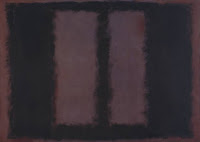The museum is imposing; a behemoth, like a whale brought in on
the tide and beached on the riverbank. Approaching it on the Millennium Bridge
from across the Thames, as we did, it looms larger and larger as we near. I am
reminded of the Periclean plan for the Acropolis, with its forced perspective
that increases the monumentality of the Parthenon. A former powerhouse, through
sheer scale and austere symmetry it commands its riverside location with a massive
form. Its single oversized chimney resembles a minaret. Though more fortress
than temple, it is a layered symbol of the power of art.
First impressions are powerful. While subsequent experiences
may rectify false notions created by them there is no doubt that first
impressions have the potential to establish a lasting bias. Museums around the
world, from Milwaukee to Bilbao, have created new architectural presences in
order to cash in on this effect. Repurposing an old power station is perhaps a
riskier if not bolder move than new construction. Its phenomenal collection is
certainly a factor, but to the renowned Swiss architects
Herzog & De Meuron, who oversaw the renovation, goes
much of the credit for its success (its own website claims that Tate Modern is
one of the top three tourist attractions in the UK.)
The Tate’s interior is as imposing as its exterior. The
famous Turbine Hall, 115 ft. tall and 500 ft. long, dwarfs all human sense of
scale. Strangely enough, I find in the spectacle of its architecture and its
spaciousness a connection with the National Gallery, two art museums that could
not be much more dissimilar in nearly every other aspect.
There is one artist, at least, who also forms a connection
between the two collections. For the most part, the Tate Modern picks up where
the National Gallery leaves off. But here too I am struck by an evocative
painting by none other than JMW Turner. That his work graces both
museums leaves little doubt of his preeminent role in the history of Modern
Art. This is not news to me, but a text panel next to the painting adds a
revelation. Mark Rothko, it seems, claims to have been inspired by Turner.
Rothko, in turn, is well represented
here at the Tate. I found the room full of wall-sized Rothko paintings to be every
bit as spiritually alive and perhaps more moving than the overtly intentional
ones at the Rothko Chapel in Houston, TX. Mark Rothko, the wall panel goes one
to say, donated these paintings to
the Tate in homage to Turner. OK, I’m
impressed.
Turner and Rothko are both long-time
favorites of mine. There are plenty of others, too, and it is fun to run across
them in this new context. (There are whole
rooms devoted to Lewis Baltz and Manuel Alvarez Bravo!) What I really
enjoy, though, is when a museum enables the discovery of unfamiliar artists.
The Tate provides such discoveries in spades.
British sculptor Cathy de Monchaux is
represented by a small piece entitled Erase. With obvious reference to both
male and female genetalia, a long steel bolt is enveloped in a red velvet-lined
denim pouch studded with rivets and held together with a fly-like zipper. Erase
is included in an extensive and excellent exhibit called “Poetry and Dream”
that intends to “show how contemporary art grows from, reconnects with, and can
provide fresh insights into the art of the past.” Monchaux, a contemporary
artist, is shown in a context of surrealists. This is just one of several such
unexpected juxtapositions that I find refreshing.
The Tate has a small gallery called
Project Space that is devoted to “presenting contemporary art through a series
of collaborations with cultural organisations around the world.” That in itself
is worth noting. The current show of mixed media is called “Ruins
in Reverse.” The theme revolves around fictive
realities that mimic archeology. I feel a particular affinity for two
photographers with connections to Peru, Pablo Hare and Eliana Otta.
There are two disappointments. The vast
Turbine Hall is famous for its equally outsized installations, but today it is
stark in it emptiness. The other disappointment is my own doing. We took
advantage of the fact that the museum is open late on Fridays to spend the day
outdoors, but by the time we reach the second floor jetlag kicks in. By the
time we reach the third floor it is hard to appreciate the great art we
continue to discover.
 |
| Minimalism gallery |
It is only day one in London. We will
have to return.
To read my post on London's National Gallery of Art, click here.
Images of Snow Storm by Turner, Black on Maroon by Rothko, and Erase by Monchaux courtesy Tate Modern website.




No comments:
Post a Comment